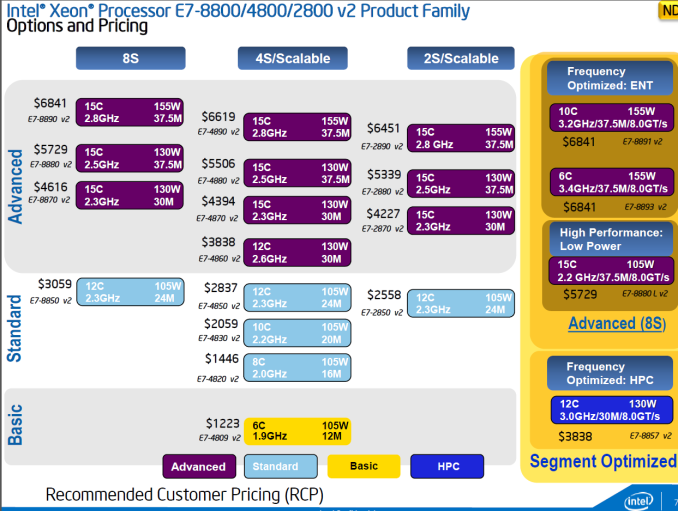The Intel Xeon E7 v2 Review: Quad Socket, Up to 60 Cores/120 Threads
by Johan De Gelas on February 21, 2014 6:00 AM EST- Posted in
- IT Computing
- Intel
- Xeon
- Ivy Bridge EX
- server
- Brickland
SKUs and Prices
Anno 2014, the only competition for the Xeon E7 v2 are the—ranging from expensive to "Exa" expensive—Oracle Superclusters, the relatively "cheap" but lowly specced IBM Power 710/720 Server Express line, or the powerful but rather expensive IBM Power 760-780 server line. As a result, the prices for Ivy Bridge EX are a lot more "RISCy". Intel feels that you should get 20% to 50% more performance for the same amount of money...
... but feels that a premium price is warranted for the two top models (4890 and 4880 v2) that offer higher performance increases. That leads to some hefty price tages:
One of the most interesting SKUs seems to be the Xeon E7-8857 v2, a native 12-core at a pretty high 3GHz clock, and which only costs 60% of the other top models.












125 Comments
View All Comments
Kevin G - Saturday, February 22, 2014 - link
Not 100% sure since I'm not an IEEE member to view it, but this paper maybe the source for the POWER7+ figures:http://ieeexplore.ieee.org/xpl/articleDetails.jsp?...
Phil_Oracle - Monday, February 24, 2014 - link
TDP is great for comparing chip to chip, but what really matters is system performance/watt. And although Intel's latest Xeon E7 v2 may have better TDP specs than either Power7+ or SPARC T5, when you look at the total system performance/watt, SPARC T5 actually leads today due to its higher throughput, core count, 4 x more threads, built-in encryption engines and higher optimization with the Oracle SW stack.Flunk - Friday, February 21, 2014 - link
8 core consumer chips now please. If you have to take the GPU off go for it.DanNeely - Friday, February 21, 2014 - link
Assuming you mean 8 identical cores, until mainstream consumer apps appear that can use more CPU resources than the 4HT cores in Intel's high end consumer chips but which can't benefit from GPU acceleration become common it's not going to happen.I suppose Intel could do a big.little type implementation with either core and atom or atom and the super low power 486ish architecture they announced a few months ago in the future. But in addition to thinking it was worthwhile for the power savings, they'd also need to license/work around arm's patents. I suppose a mobile version might happen someday; but don't really see a plausible benefit for laptop/desktop systems that don't need continuous connected standby like phones do.
Kevin G - Friday, February 21, 2014 - link
Intel hasn't announced any distinct plans to go this route, they're at least exploring the idea at some level. The SkyLake and Knights Landing are to support the same ISA extensions and in principle a program could migrate between the two types of cores.StevoLincolnite - Saturday, February 22, 2014 - link
Er. You don't need apps to use more than 4 threads to make use of an 8 core processor.Whatever happened to running several demanding applications at once? Surely I am not the only one who does this...
My Sandy-Bridge-E processor being a few years old is starting to show it's age in such instances, I would cry tears of blood for an 8-Core Haswell based processor to replace my current 6-core chip.
psyq321 - Monday, March 10, 2014 - link
Well, you can buy bigger Ivy Bridge EP Xeon CPU and fit it in your LGA2011 system.This way you can go up to 12 cores and not have to wait for 8-core Haswell E.
SirKnobsworth - Friday, February 21, 2014 - link
8 core Haswell-E chips are due out later this year. You can already buy 6 core Ivy Bridge-E chips with no integrated graphics.TiGr1982 - Friday, February 21, 2014 - link
Did you know:Haswell-E is supposed to be released in Q3 this year, to have up to 8 Haswell cores with HT, fit in the new revision of Socket LGA2011 (incompatible with the current desktop LGA2011), and work with DDR4 and X99 chipset. No GPU there, since it's a byproduct of server Haswell-EP.
Harry Lloyd - Friday, February 21, 2014 - link
That will not help much, unless they release a 6-core chip for around 300 $, replacing the lowest LGA2011 4-core chips. It is about time.